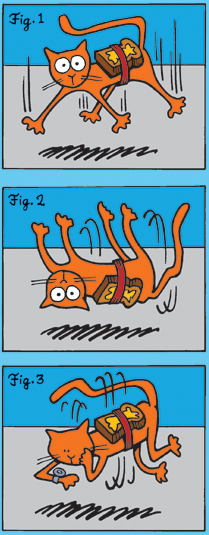Q: If you drop a buttered piece of bread, it will fall on the floor butter-side down. If a cat is dropped from a window or other high and towering place, it will land on its feet, But what if you attach a buttered piece of bread, butter-side up to a cat’s back and toss them both out the window? Will the cat land on its feet? Or will the butter splat on the ground?
A: Even if you are too lazy to do the experiment yourself you should be able to deduce the obvious result. The laws of butterology demand that the butter must hit the ground, and the equally strict laws of feline aerodynamics demand that the cat can not smash its furry back. If the combined construct were to land, nature would have no way to resolve this paradox. Therefore it simply does not fall.
That’s right you clever mortal (well, as clever as a mortal can get), you have discovered the secret of antigravity! A buttered cat will, when released, quickly move to a height where the forces of cat-twisting and butter repulsion are in equilibrium. This equilibrium point can be modified by scraping off some of the butter, providing lift, or removing some of the cat’s limbs, allowing descent.
Most of the civilized species of the Universe already use this principle to drive their ships while within a planetary system. The loud humming heard by most sighters of UFOs is, in fact, the purring of several hundred tabbies. The one obvious danger is, of course, if the cats manage to eat the bread off their backs they will instantly plummet. Of course the cats will land on their feet, but this usually doesn’t do them much good, since right after they make their graceful landing several tons of – starship and off aliens crash on top of them.
And now a few words on solving the problem of creating a ship using the aforementioned anti-gravity device. One could power a ship by means of cats held in suspended animation (say, about -190 degrees Celsius) with buttered bread strapped to their backs, thus avoiding the possibility of collisions due to temperamental felines. More importantly, how do you steer, once the cats are all held in stasis?
I offer a modest proposal: We all know that wearing a white shirt at an Italian restaurant is a guaranteed way to take a trip to the Laundromat. Plaster the outside of your ship with white shirts. Place four nozzles symmetrically around the ship, which is, of course, saucer shaped. Fire tomato sauce out in proportion to the directions you want to go. The ship, drawn by the shirts, will automatically follow the sauce. If you use T-shirts, you won’t go as fast as you would by using, say, expensive dress shirts. This does not work as well in deep gravity wells, since the tomato sauce (now falling down a black hole, perhaps) will drag the ship with it, despite the counter force of the anti-gravity cat/butter machine. Your only hope at that point is to jettison enormous quantities of Tide. This will create the well-known Gravitational Tidal Force.
AND THE RESPONSE TO THIS from a fan of the experimental scientific method: This is a clear case of the difference between theoretical and experimental science. Experimental science demonstrates that nature does not “resolve” paradoxes, it simply prevents them from arising in the first place. In this case, that prevention was apparently caused by an old scientific axiom — the act of performing an experiment may invalidate its outcome. The most well known example of this is the Heisenberg uncertainty principle from physics. Recognizing that something similar might be going on, the suggested experiment was performed 100 times using 100 volunteer experimenters, 100 slices of buttered bread, and 100 (uncooperative) cats. Results are summarized below:
- 51 cases reported that the cat escaped prior to being configured for the experiment.
- 24 cases reported that the cat delivered sufficient damage to the bread holding apparatus that the experiment could not be performed.
- 23 cases reported that the cat delivered sufficient damage to the experimenter that the experiment could not be performed.
- 1 case reported that the bread revolved around the cat until the butter side was face down on the cat’s belly, at which point the cat landed on its feet and the bread landed butter side down.
- Two cases failed to report their results, but the labs in which the experiments were planned to take place are now rubble. In both cases, bloody cat prints were seen leading away from the epicenter of the devastation.
- Zero cases reported any observable antigravity.
Although results are preliminary, we believe the cat-butter paradox is prevented from ever happening by what we have tentatively called “the certainty principle” — that any cat facing this experiment is certain to be an unwilling participant.
Disclaimer: No actual cats were injured in the course of these experiments. Alas, the same cannot be said for bread (or experimenters).

Sorry, the comment form is closed at this time.